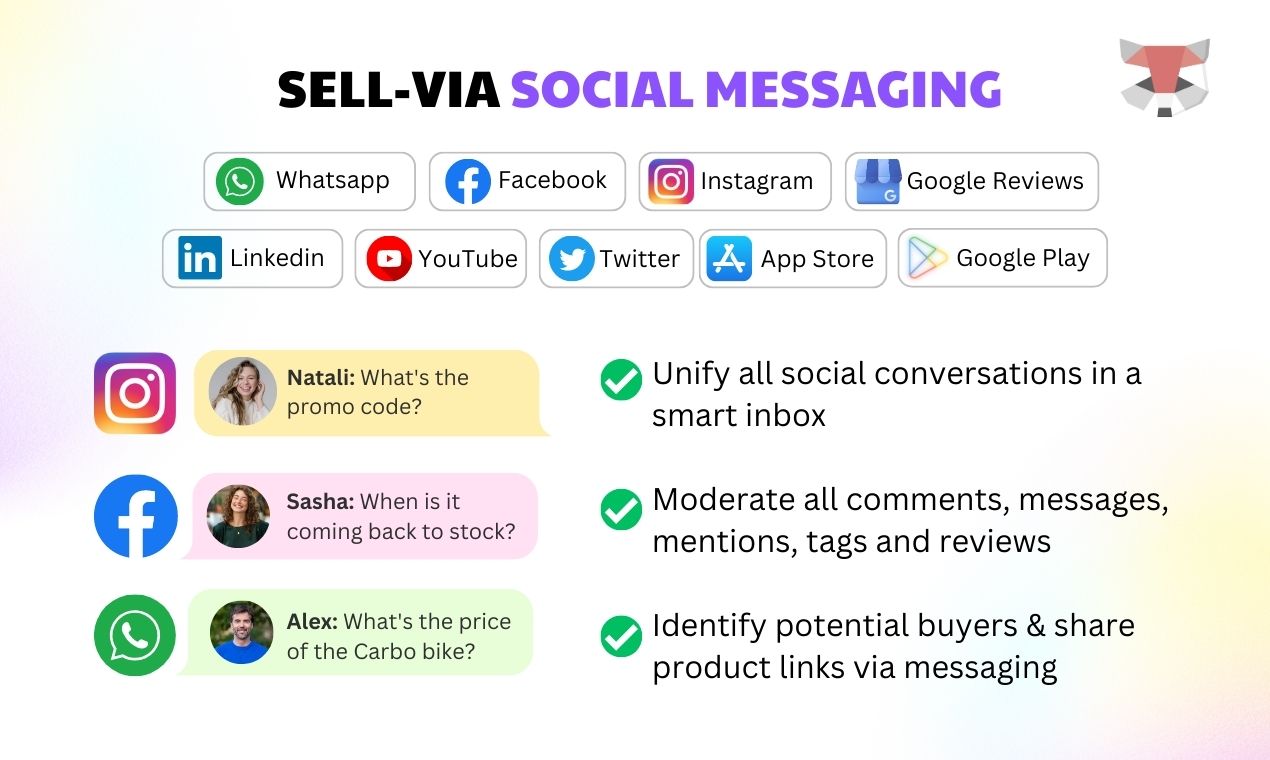The Power of User-Generated Content in Social Commerce
Inci Vardar
The shopping experience is constantly shifting as new technologies and platforms emerge. First, it moved from physical shopping to e-commerce, and now it is turning into more and more social commerce. Not only online marketplaces but also some social media platforms like Facebook and Instagram became a direct point of sales. Today almost all consumers search for product information online and seek social proof to make a buying decision. Since a brand’s marketing content is neither neutral nor completely trustworthy, buyers turn to user-generated content (UGC) to make smarter choices. In this article, we’ll explain what UGC is and how we can harness its power for brands.

What Is User-Generated Content?
UGC, short for user-generated content, is all the brand-related content consumers create to share their experiences, love, or disappointment with a product. It is vital for social commerce because online reviews and social media are two of the main sources that today’s shoppers, especially the younger generations, obtain detailed information on brands, products, and services.
Consumers know perfectly well that brands and marketers are biased. It doesn’t mean that they deliberately mislead the customer – it is only about the difference in primary objectives. Brands are focused on sales, so marketers highlight the stronger features of products. But this selective information might not always provide the full picture.
That’s why the most valuable type of UGC is unpaid. The copy can be sloppy, and visuals may not look as polished as product photos taken by the brand, but UGC is definitely more relatable, engaging, and authentic.
Types of User-Generated Content
User-generated content can be an Instagram photo, an unboxing video on YouTube, reviews on an e-commerce website, a blog piece that explains the key features, a question asked through a brand’s customer support account on Twitter, and so on and so forth.
Customers, employees, or influencers can create UGC. The main point is that the content is relevant to the brand, and the public, created by someone who actually used the product / service, and it has the potential to influence other people’s decisions.
It is important to figure out what types of UGC can be utilized for specific industries. For example, UGC on Instagram is obviously more beneficial for a brand in the fashion industry, while a fintech company can make better use of a testimonial posted on a review site.
How User-Generated Content can be Leveraged by Brands?
Most of the time, brands reshare user-generated content on their social accounts and websites. According to Forbes, over 86% of companies use UGC as a part of their marketing endeavors, as UGC ads “receive four times higher click-through rates and a 50% drop in cost-per-click compared to average ads.” The results are worth encouraging UGC creation through contests, gifts, rewards, and recognition.
Although organic UGC is the most desirable form of flattery, there is no guarantee that the content will reflect the desired brand identity or messages, while companies usually have no control over the outcome. In order to tackle this problem, brands usually collaborate with a select group of loyal customers and micro-influencers. It is possible to educate creators about the brand’s identity and marketing messages to ensure consistency and reusability.
This kind of UGC has several advantages.
- First of all, the content will align with what you want to communicate but in a more authentic way.
- You can benefit from creators’ expertise because they know what works and what doesn’t on specific platforms.
- UGC saves you time on content creation and distribution, making it easier to raise awareness since the influencers already address a highly engaged audience.
- You can repurpose UGC on different platforms. For example, a TikTok video can be used in Instagram Reels, a review can take place on your email signature, questions for customer support can enrich the FAQ page of your website, and displaying Instagram photos on your product page can encourage shoppers to try out your brand.
Just don’t forget to ask permission to use the content, preferably in written form. Even though the content is about you, remember that it is not actually yours.
Which Platforms Offer User-Generated Content?
All social platforms are full of user-generated content, but some platforms take this one step further. Platforms like Foursixty and Taggbox help you collect, curate and publish UGC across multiple platforms, as well as create shoppable galleries and obtain content rights from users. Flowbox, another UGC platform, offers advanced AI tools that help to prioritize UGC and link it to products through a visual search engine.
While these platforms offer great advantages, especially with shoppable Instagram galleries, they might be too advanced for some brands. For example, some brands, such as those offering digital services, have limited visual resources available, while others receive smaller amounts of UGC, and investing in such a platform may seem redundant. However, that doesn’t reduce the importance of UGC tracking and customer engagement.
Considerations and Challenges of User-Generated Content
While UGC carries tremendous potential for your marketing strategy, it also brings certain challenges that must be anticipated and managed efficiently. Foreseeing these concerns will better equip you to harness the power of UGC.
Firstly, not all user-generated content will be positive. It’s inevitable to encounter negative reviews or feedback. While it might seem detrimental at first, these moments can serve as opportunities. Engaging with dissatisfied customers, addressing their concerns, and demonstrating a commitment to improving can enhance your brand’s reputation for transparency and customer service.
Moreover, curating and managing UGC effectively can be a significant investment in terms of time and resources. From tracking mentions and hashtags and sorting through relevant content to obtaining permissions for reuse, there’s a lot involved in the process. However, as we’ll discuss later, there are tools like Juphy that can streamline these processes, making UGC management more efficient.
Another challenge to consider is the balance between encouraging user creativity and maintaining brand identity. While UGC provides an authentic and relatable perspective, ensuring the content aligns with your brand identity and messaging can be a delicate act. This is where establishing clear guidelines for content creators, particularly influencers or brand ambassadors, comes into play.
Lastly, quality control can also be a challenge with UGC. Unlike brand-generated content, UGC might not always match your brand’s aesthetics or quality standards. Embracing this variance is part of the authenticity UGC offers, but it’s crucial to curate the content that best represents your brand while resonating with your audience.
By addressing these challenges head-on, you’ll be better prepared to maximize the potential of UGC for your brand’s social commerce strategy. Now, let’s look at how Juphy can simplify the UGC management process…
Improve User-Generated Content Performance with Juphy
Ever felt overwhelmed trying to manage all your social media engagement and user-generated content (UGC)? Well, breathe easy. Juphy, an all-encompassing social media moderation tool, is here to help you out. Its aim? To help you fine-tune your content’s performance across all platforms.
Integration with various social media channels, like Facebook, Instagram, Twitter, LinkedIn, YouTube, Google My Business, and WhatsApp, is what makes Juphy a standout performer. It allows you to manage all your social media conversations in one place. No more flipping between apps or tabs, giving you more time to focus on what truly matters – crafting engaging content and building relationships with your audience.

One of the many useful features Juphy offers is real-time keyword and hashtag tracking. Specify keywords that are important to your brand, and Juphy will notify you instantly in your social inbox when they appear across your social media channels. This gives you the chance to react promptly and appropriately to any mentions of your brand.
But that’s not all! Juphy’s automation rules let you sort incoming messages based on their content, urgency, and tone. This ensures that all essential interactions are brought to your attention. With the addition of team collaboration features, your internal communication becomes a piece of cake, improving your overall productivity.

While Juphy has a plethora of benefits, it’s worth noting that it’s particularly effective for businesses or scenarios that have heavy social media engagement or rely on user-generated content. For smaller businesses or those with less frequent social media interaction, a more customized solution may be needed.
As well as all of this, Juphy offers canned responses to common questions. This means you can respond to your audience quickly and consistently. Additionally, Juphy’s reports dashboard gives you valuable insights into your performance, allowing you to make informed decisions based on your data.
But hey, don’t just take our word for it. Setting up Juphy is as easy as pie, and you can start your 7-day free trial today. Find out for yourself how Juphy can make managing user-generated content and audience interactions easier.
FAQ
UGC is any brand-related content created by consumers sharing their experiences, love, or disappointment with a product or service.
UGC is vital because it provides authentic, relatable, and engaging content that helps build trust, credibility, and social proof for brands.
UGC can include Instagram photos, unboxing videos, reviews, blog posts, and questions asked through a brand’s customer support account on Twitter.
Brands can reshare UGC on their social accounts and websites, collaborate with loyal customers and micro-influencers, and repurpose content across different platforms.
Organic UGC is more valuable as it is unbiased and authentic, reflecting genuine customer experiences, although collaborating with creators can help ensure consistency and reusability.
Related Article – Business Direct Message Instagram Examples

Get inspired by real business direct message Instagram examples and learn how to ace your messaging game. Slide into succession on Instagram! Read more now!


